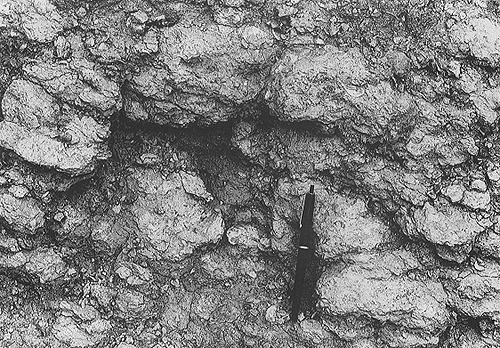
Diffuse bioturbation and mottling
Plate 145

Diffuse bioturbation and mottling
Plate 145
We have seen that many sedentary benthic organisms, both plants and animals, are sediment builders: they either trap passing solid particles or extract ions from water and build up carbonate accumulations. On the other hand, mobile benthos, represented by animals living on or under the sedimentary interface, disturbs and modifies already existent sediment. Part of its activity occurs above the bottom, and leaves interfacial, or superficial traces; another part consists in penetrating and crossing the sediment mass, which leads to internal traces. On the one hand, therefore, we have, broadly speaking and simplifying things, grazing and crawling organisms, on the other tunneling and burrowing organisms.
Burrows are distinct animal traces, whose preservation depends on their stuffing with organic matter (excretions) and sediment. They are sedimentary structures of their own, but at the same time, like an eraser, cancel previous structures along their pathway. As burrows grow in number, the degree of obliteration of primary structures and of sediment churning increases; the end product is an entirely homogenized, structureless bed or, as in the case illustrated here, a mottled bed. Mottling can be overprinted by secondary (diagenetic) effects, consisting for example in the selective precipitation of chemical cement, which gives the sediment a nodular or encrusted aspect. This depends on the fact that porosity and permeability are not uniformly distributed in the sediment, and vary from place to place.
Homogenized and mottled sediments are 100% bioturbated. Single animal traces cannot be identified, but there is nonetheless an important indication concerning the relative rate of sedimentation. In fact, rapidly accumulating sediments are rapidly buried as well; taking a relativistic stand, we say that they cross the depositional interface at a high velocity. This means that the sediments remain exposed to biological activity for a short time only, as the animals cannot penetrate beyond a critical depth (they need oxygen, among other things). Bioturbation will thus be minimal or absent when the rate of sedimentation is high. When and where sedimentation is slower, burrowers rework the sediment for a longer time and the extent of bioturbation increases. In conclusion, the amount of bioturbation is a rough, relative indicator of the deposition rate; fully bioturbated levels, in particular, reveal episodes of slow or interrupted sedimentation. For example, marine "blue" clays of Plio-Quaternary age filling part of the Po Basin and onlapping the margin of the Apennines, accumulated at a rate of about 1 mm/year, which is quite a high rate. At some levels, mottled sand-clay mixtures like those shown by the picture point out pauses in sedimentary supply. Some shells are scattered in the sediment, but burrowing organisms do not necessarily leave their remains; most of them are soft-bodied animals.